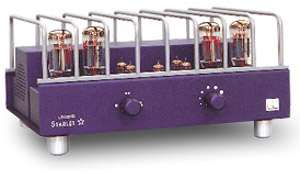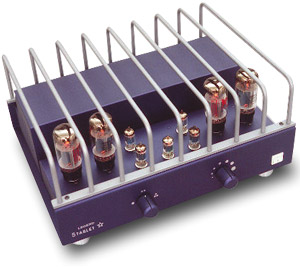![[SoundStage!]](../titles/sslogo3.gif) Home
Audio Home
Audio Equipment Review |
||||||||||||||||||||||
May 2001 Legend Audio Starlet Integrated Amplifier by Paul Schumann
Back in the days of my youth (which are growing more distant by the minute), tube audio equipment was cheap and plentiful. All you had to do was go down to the local hi-fi store and pick a system using components from Fisher, Marantz, Harmon/Kardon or McIntosh and you were set. If you wanted to save a few bucks, you could build a kit yourself from Heathkit or Dynaco. There are no official numbers on this, but the Dynaco ST-70 was probably the most popular amplifier ever sold. I sure knew about it; I grew up with the one my dad built. By the early '70s, the tide had turned, and tubes were no longer cool. If it weren’t for the vision of William Johnson at Audio Research, tubes might have disappeared altogether from the home-audio industry. Fortunately Audio Research forged ahead, and along with Conrad-Johnson, started a whole new era of high-end tube-based audio products. Unfortunately, for most people these items were a bit pricey and, as befitting their high-end status, were always offered as separate amps and preamps. For poor shlubs like me, the old Dynaco gear would have to do. Then, about five years ago, a company named JoLida introduced a line of tube-based integrated amplifiers that sold at reasonable prices. These were an instant success (I bought one) and helped fuel the high-end integrated-amp revolution. Suddenly, every manufacturer of tube gear had an integrated amplifier on the market. Now, Legend Audio throws the Starlet into the ring. More history -- and other stuff Legend Audio is a California-based audio company that has received lauds for its preamplifiers and monoblock amplifiers, and the company used what it learned to create this gear in designing the $2995 USD Starlet. Instead of a passive line stage like that in some JoLida integrated amps, the preamp stage of the Starlet is completely active, using 12AU7s all around. The output stage consists of two pairs of 6550s in push-pull configuration, connected as triodes. This configuration, while less common, was used in the past by Audio Research for their Classic series of amplifiers and is currently used successfully by a few companies other than Legend. The reasoning for this configuration is that you can attain the linearity of a direct-heated triode, such as a 2A3 or 300B, without the hum and noise that directly heated filaments can add. Since the 6550s are connected as triodes, their power output is reduced accordingly. Legend Audio rates the Starlet at 40Wpc at no more than 1% THD and with a signal to noise ratio of 92dB, which is not unusual for a push-pull tube amp. Also featured in the Starlet’s design are an ALPS potentiometer, Holco resistors, Solen and Siemens capacitors, and point-to-point wiring using silver wire in the signal path. Reading all of this information while waiting for the Starlet to arrive made me all the more anxious. When the Starlet did arrive, I was struck with the size of its box. Not surprisingly, once the box was opened, it revealed one big and heavy integrated amplifier. The literature supplied by Legend Audio lists the Starlet at 65 pounds. I don’t know if it’s that heavy, but it sure is a load. If you purchase the Starlet, just make sure you have a very sturdy stand to place it on. What also immediately struck me about the Starlet's appearance was the color. In the photos from the company's website, the Starlet appeared to be gray, but imagine my surprise when I discovered that it is actually purple. This purple body is accented with a silver cage. Surprisingly, I really didn’t notice the color scheme once the Starlet was placed in my system. For those of you who are less adventurous, Legend Audio now offers a more traditional black with a brass-colored cage.
Listening Initially I used my Thiel CS1.5 speakers to review the Starlet. Despite their lower sensitivity, I felt I had no cause for concern since my 40Wpc JoLida SJ202A had always driven them nicely. Knowing that silver wire was used in the Starlet, I thought that it might take some time for the Starlet to show its true character. Despite giving the Starlet a couple of months, I found there were some concerning characteristics that remained. The most obvious were a constant edge in the upper midrange and a constriction of dynamics. I soon found it more and more difficult to sit down and listen to my system.
Concerned with this, I contacted some of the SoundStage! brain trust for advice. We decided that there might be a poor interaction between the Thiel speakers and the Starlet -- an impedance mismatch, most likely. The Thiels are not an easy load, which is why they are so often driven with solid-state electronics. So I decided to try the supposedly easier-to-drive Silverline Panatella II speakers, which I had recently received for review. Since I was not familiar with the Panatella IIs, I put my JoLida back in the system to break them in and familiarize myself with their sonics. It was with these speakers that all the following observations were made. I would characterize the Starlet as definitely on the darker side of the sonic spectrum. Most modern tube equipment, no matter how it is voiced, is always able to reproduce the high-frequency air associated with string instruments. The Gladiator soundtrack [Decca 289 467 094-2] is loaded with this high-frequency information, which is one of the strengths of this CD. The Starlet, however, failed to capture much of what was happening; the air just wasn't there. The Starlet's midrange is fairly uncolored until the gain is turned up to reveal a fuzziness added to the music. This is most easily heard on massed strings. A good benchmark recording is Brahms’ Second Symphony by Charles Mackerras and the Scottish Chamber Orchestra [Telarc 80450]. There is nothing sugarcoated about this recording. If reproduced correctly, the strings should sound very clean. Yet when played through the Starlet, the recording takes on an added haze. As the complexity of music increases, this haze increases also, causing an overall muddying effect of the music. And as I would expect, this fuzziness affects other areas of the Starlet’s sound. Almost every recording has a distant perspective, as if an extra cushion of air were inserted between the performers and the microphones. There is also a general flattening of the soundstage, making it almost two-dimensional. Perhaps the most impressive aspect of the Starlet’s sound is its bass. Whether it be the thunderous bass-drum thwacks that introduce Copland’s Fanfare for the Common Man [Reference Recordings RR-93CD] or the growling double basses in Gorecki’s Third Symphony [Elektra Nonesuch 7559-79282-2], the Starlet comes through. Only on some of the most challenging bass dynamics does the Starlet seem to lose steam, but this can be expected with a 40Wpc tube amplifier.
The longer I’ve been listening to audio equipment, the more I’ve become convinced that reproduction of dynamics is one of the keys to unlocking the wonder of recorded music. I’m not talking about thundering drums or crashing cymbals or blaring horns, as fun as those may be. I’m talking about the subtleties of a musical performance, such as an accent on a syllable or the differences between an upstroke and a downstroke on a violin. These subtleties are what most direct-heated triode amplifiers get so right. Since the Starlet uses the 6550s in triode mode, it was this aspect I was particularly interested in. Unfortunately, the Starlet fails to deliver. Whether it was normally beautifully nuanced vocals of the Anonymous 4 on A Star in the East [Harmonia Mundi HMU 907139], or the subtle playing of Emil Gilels on Edvard Grieg’s Lyric Pieces [Deutsche Grammophon 499 721-2], or the intricate interplay of the Bill Evans Trio on Waltz for Debbie [Analogue Productions APJ 009], the Starlet failed to bring out the microdynamic nuances in these recordings. No matter what volume setting I used, all were afflicted with this sameness, as if all the life had been squashed out of the music. The only other tube-based integrated amplifier that I am well acquainted with is my $750 JoLida SJ202A. I’ll be the first to admit that the JoLida has faults. It has a warm midrange, and in terms of that warmth, the SJ202A and the Starlet are bedfellows. However, in the case of the JoLida integrated amp, this warmth never intrudes upon the music itself unless I'm using the most insensitive of speakers. The Starlet's authoritative bass is notable when compared to the JoLida's more tubelike bottom end, but what really makes the JoLida SJ202A shine is its ability to communicate the emotion of the music. Sure, it doesn’t have the mojo of a direct-heated triode amp, but it does a pretty good job, and is compatible with a fair share of speakers. Conclusion If someone had given me a Starlet to listen to back when I was just starting out my audio journey, I might have been impressed with its warmth and powerful bass. But as I have come to understand what separates the average gear from gear that can capture the magic of music, I’ve raised my standards for what a component should do. This must especially be true for an integrated amplifier costing $2995. Perhaps my experiences with the Starlet and two different pairs of speakers were indicative of some sort of mismatch, or perhaps I myself require something different from audio equipment than the Starlet is designed to deliver. Whatever the case, in my system and with my tastes, the Legend Audio Starlet is a noble effort that falls short of the mark. ...Paul Schumann
|
||||||||||||||||||||||
|
||||||||||||||||||||||
![[SoundStage!]](../titles/sslogo3.gif) All
Contents All
ContentsCopyright © 2001 SoundStage! All Rights Reserved |

 The Starlet is
minimalist in terms of features: three inputs, a detachable power cord, a three-way
selector, volume control and rocker-type power switch. The binding posts do not include
multiple taps. The version I was provided was set up for a 4-ohm load; configuration for
8- or 16-ohm loads is available from Legend Audio. The Starlet is supplied with five
Phillips JAN 5814As. These are military-grade NOS versions of the 12AU7 tube. Using these
older tubes is a nice touch. The four 6550s used for the output stage are reliable new
Sovteks. I didn’t do any tube rolling because I wanted to listen to the Starlet as
Legend Audio intended.
The Starlet is
minimalist in terms of features: three inputs, a detachable power cord, a three-way
selector, volume control and rocker-type power switch. The binding posts do not include
multiple taps. The version I was provided was set up for a 4-ohm load; configuration for
8- or 16-ohm loads is available from Legend Audio. The Starlet is supplied with five
Phillips JAN 5814As. These are military-grade NOS versions of the 12AU7 tube. Using these
older tubes is a nice touch. The four 6550s used for the output stage are reliable new
Sovteks. I didn’t do any tube rolling because I wanted to listen to the Starlet as
Legend Audio intended.